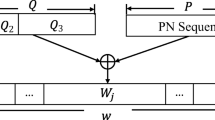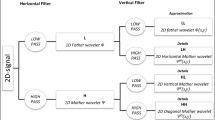Abstract
This paper presents a patchwork-based watermarking method for stereo audio signals, which exploits the similarity of the two sound channels of stereo signals. Given a segment of stereo signal, we first compute the discrete Fourier transforms (DFTs) of the two sound channels, which yields two sets of DFT coefficients. The DFT coefficients corresponding to certain frequency range are divided into multiple subsegment pairs and a criterion is proposed to select those suitable for watermark embedding. Then a watermark is embedded into the selected subsegment pairs by modifying their DFT coefficients. The exact way of modification is determined by a secret key, the watermark to be embedded, and the DFT coefficients themselves. In the decoding process, the subsegment pairs containing watermarks are identified by another criterion. Then the secret key is used to extract the watermark from the watermarked subsegments. Compared to the existing patchwork methods for audio watermarking, the proposed method does not require knowledge of which segments of the watermarked audio signal contain watermarks and is more robust to conventional attacks.


Similar content being viewed by others
References
Al-Nuaimy W, El-Bendary MAM, Shafik A, Shawki F, Abou-El-azm AE, El-Fishawy NA, Elhalafawy SM, Diab SM, Sallam BM, El-Samie FEA, Kazemian HB (2011) An SVD audio watermarking approach using chaotic encrypted images. Digital Signal Process 21(6):764–779
Arnold M (2000) Audio watermarking: features, applications and algorithm. In: IEEE International conference on multimedia expo 2000, pp 1013–1016
Baras C, Moreau N, Dymarski P (2006) Controlling the inaudibility and maximazing the robustness in an audio annotation watermarking system. IEEE Trans Audio Speech Language Process 14(5):1772–1782
Bender W, Gruhl D, Morimoto N, Lu A (1996) Techniques for data hiding. IBM Syst J 35(3–4):313–336
Bhat KV, Sengupta I, Das A (2010) An adaptive audio watermarking based on the singular value decomposition in the wavelet domain. Digital Signal Process 20(6):1547–1558
Cao W, Yan Y, Li S (2009) Bit replacement audio watermarking using stereo signals. In: Int. conf. new trends in information and service, pp 603–606
Chen OT-C, Wu W-C (2008) Highly robust, secure, and perceptual-quality echo hiding scheme. IEEE Trans Audio Speech Language Process 16(3):629–638
El’Arbi M, Koubaa M, Charfeddine M, Ben Amar C (2011) A dynamic video watermarking algorithm in fast motion areas in the wavelet domain. Multimed Tools Appl 55(3):579–600
Erçelebi E, Batakçi L (2009) Audio watermarking scheme based on embedding strategy in low frequency components with a binary image. Digital Signal Process 19(2):265–277
Erfani Y, Siahpoush S (2009) Robust audio watermarking using improved TS echo hiding. Digital Signal Process 19(5):809–814
Fallahpour M, Megias D (2011) High capacity audio watermarking using the high frequency band of the wavelet domain. Multimed Tools Appl 52(2–3):485–498
Foo SW (2008) Audio-watermarking with stereo signals. In: TENCON 2008–2008 IEEE region 10 conf., pp 1–4
Huang CH, Chuang SC, Huang YL, Wu JL (2009) Unseen visible watermarking: a novel methodology for auxiliary information delivery via visual contents. IEEE Trans Inf Forensics Security 4(2):193–206
Huang H, Yang C, Hsu W (2009) A video watermarking technique based on pseudo-3-D DCT and quantization index modulation. IEEE Trans Inf Forensics Security 5(4):625–637
Kalantari NK, Akhaee MA, Ahadi SM, Amindavar H (2009) Robust multiplicative patchwork method for audio watermarking. IEEE Trans Audio Speech Language Process 17(6):1133–1141
Kirbiz S, Gunsel B (2006) Robust audio watermark decoding by supervised learning. In: IEEE International conference on acoustics, speech and signal processing, pp 761–764
Kirovski D, Malvar H (2001) Robust spread-spectrum audio watermarking. In: IEEE International conference on acoustics, speech and signal processing, pp 1345–1348
Ko B-S, Nishimura R, Suzuki Y (2005) Time-spread echo method for digital audio watermarking. IEEE Trans Multimed 7(2):212–221
Kondo K, Nakagawa K (2008) A digital watermark for stereo audio signal using variable interchannel delay in high frequency bands. In: Int. conf. intelligent information hiding and multimedia signal process, pp 624–627
Lakshmi D, Ganesh R, Marni R, Prakash R, Arulmozhivarman P (2008) SVM based effective watermarking scheme for embedding binary logo and audio signals in images. In: TENCON 2008—2008 IEEE Region 10 conference, pp 1–5
Lie W-N, Chang L-C (2006) Robust and high-quality time-domain audio watermarking based on low-frequency amplitude modification. IEEE Trans Multimed 8(1):46–59
Lin WH, Horng SJ, Kao TW, Fan P, Lee CL, Pan Y (2008) An efficient watermarking method based on significant difference of wavelet coefficient quantization. IEEE Trans Multimed 10(5):746–757
Lin WH, Horng SJ, Kao TW, Chen RJ, Chen YH, Lee CL, Terano T (2009) Image copyright protection with forward error correction. Expert Syst Appl 36(9):11888–11894
Lin WH, Wang YR, Horng SJ (2009) A wavelet-tree-based watermarking method using distance vector of binary cluster. Expert Syst Appl 36(6):9869–9878
Lin WH, Wang YR, Horng SJ, Pan Y (2009) A blind watermarking method using maximum wavelet coefficient quantization. Expert Syst Appl 36(9):11509–11516
Liu CS (2005) Multimedia security: steganography and digital watermarking techniques for protection of intellectual property. Idea Group Publishing, Hershey, PA
Luo L, Chen Z, Chen M, Zeng X, Xiong Z (2010) Reversible image watermarking using interpolation technique. IEEE Trans Inf Forensics Security 5(1):187–193
Malvar HS, Florencio D (2003) Improved spread spectrum: a new modulation technique for robust watermarking. IEEE Trans Signal Process 52(4):898–905
Mohammad AA (2012) A new digital image watermarking scheme based on Schur decomposition. Multimed Tools Appl 59(3):851–883
Natgunanathan I, Xiang Y, Rong Y, Zhou W, Guo S (2012) Robust patchwork-based embedding and decoding scheme for digital audio watermarking. IEEE Trans Audio Speech Language Process 20(8):2232–2239
Oppenheim AV, Schaffer RW (1998) Discrete-time signal processing. Prentice-Hall, Upper Saddle River, NJ
Peng D, Xiang Y (2010) Underdetermined blind separation of non-sparse sources using spatial time-frequency distributions. Digital Signal Process 20(2): 581–596
Rec. B.S. 1387 (2001) Methods for objective measurements of perceived audio quality. Rec. B.S. 1387, Int. Telecomm. Union, Geneva, Switzerland
Rosiyadi D, Horng SJ, Fan P, Wang X, Khan M, Pan Y (2012) An efficient copyright protection scheme for e-government document images. IEEE Multimedia 19(3):62–73
Singh J, Garg P, De AN (2012) Audio watermarking based on quantization index modulation using combined perceptual masking. Multimed Tools Appl 59(3):921–939
Solanki K, Jacobsen N, Madhow U, Manjunath BS, Chandrasekaran S (2004) Robust image-adaptive data hiding based on erasure and error correction. IEEE Trans Image Process 13(12):1627–1639
Takahashi A, Nishimura R, Suzuki Y (2005) Multiple watermarks for stereo audio signals using phase-modulation techniques. IEEE Trans Signal Process 53(2):806–815
Valizadeh A, Wang ZJ (2011) Correlation-and-bit-aware spread spectrum embedding for data hiding. IEEE Trans Inf Forensics Security 6(2):267–282
Wang X, Qi W, Niu P (2007) A new adaptive digital audio watermarking based on support vector regression. IEEE Trans Audio Speech Language Process 15(8):2270–2277
Wang XY, Zhao H (2006) A novel synchronization invariant digital watermarking scheme based on DWT and DCT. IEEE Trans Signal Process 54(12):4835–4840
Wei L, Wei S, Hongtao H (2012) Novel robust image watermarking based on subsampling and DWT. Multimed Tools Appl 60(1):31–46
Wu SQ, Huang JW, Shi YQ (2005) Efficiently self-synchronized audio watermarking for assured audio data transmission. IEEE Trans Broadcast 51(1):69–76
Xiang Y (2008) Blind source separation based on constant modulus criterion and signal mutual information. Comput Electric Eng 34(5):416–422
Xiang Y, Peng D, Natgunanathan I, Zhou W (2011) Effective pseudonoise sequence and decoding function for imperceptibility and robustness enhancement in time-spread echo based audio watermarking. IEEE Trans Multimed 13(1):2–13
Xiang Y, Natgunanathan I, Peng D, Zhou W, Yu S (2012) A dual-channel time-spread echo method for audio watermarking. IEEE Trans Inf Forensics Security 7(2):383–392
Xiang Y, Peng D, Xiang Y, Guo S (2013) Novel Z-domain precoding method for blind separation of spatially correlated signals. IEEE Trans Neural Netw Learn Syst 24(1):94–105
Yeo IK, Kim HJ (2003) Modified patchwork algorithm: a novel audio watermarking scheme. IEEE Trans Speech Audio Process 11(4):381–386
Acknowledgements
This work was supported in part by the Australian Research Council under grants DP1095498 and DP110102076, the National Basic Research Program of China (973 Program) under grant 2011CB302201, and the National Natural Science Foundation of China under grant 61172180.
Author information
Authors and Affiliations
Corresponding author
Rights and permissions
About this article
Cite this article
Natgunanathan, I., Xiang, Y., Rong, Y. et al. Robust patchwork-based watermarking method for stereo audio signals. Multimed Tools Appl 72, 1387–1410 (2014). https://doi.org/10.1007/s11042-013-1454-4
Published:
Issue Date:
DOI: https://doi.org/10.1007/s11042-013-1454-4




